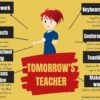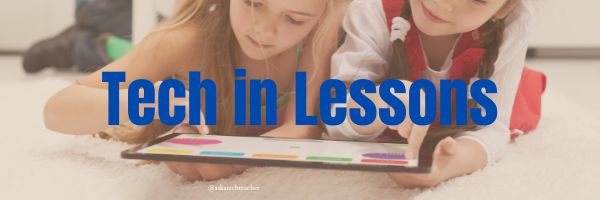Category: Education reform
Parents as Educators
When I grew up, teachers ran the classroom and parents stepped back, but a lot has changed in thirty years. COVID hit schools hard, closing them down and forcing parents to become teachers. Most schools are again open, but parents found that their children learn better when education is a three-legged stool: Parents, teachers, and kids.
Ask a Tech Teacher contributor, Drew Allen, is an active working parent with some ideas on the new reality of parents-as-educators:
Managing Your Kids Needs as Educator and Parent
If you’re a teacher and you have children yourself, you face a somewhat different set of challenges than parents who aren’t teachers or teachers without children. Whether you work at the elementary level, with older kids or college students, managing the responsibilities you have to kids both at work and at home can be daunting. However, there are several things you can do to make this easier. If you aren’t an educator, many of the tips below will still apply.
Switching Roles
There can be something whiplash inducing about bouncing between the role of teacher talking to parents and parent talking to teachers. Even as you know there are certain behaviors that you dislike in a parent during a conference, you can find yourself displaying them yourself. Above all, you may know how unhelpful it is as a parent to lean on your professional authority when you’re talking to other teachers about your kid. Resist this temptation or you could end up pushing the educator away, leaving them reluctant to involve you further in your child’s education. It’s also important that you give the educator authority when your child asks for help with their homework or other tasks. Of course, you can help them, but try to defer to their teacher unless there is some good reason not to.
Share this:
- Click to share on Facebook (Opens in new window) Facebook
- Click to share on X (Opens in new window) X
- Click to share on LinkedIn (Opens in new window) LinkedIn
- Click to share on Pinterest (Opens in new window) Pinterest
- Click to share on Telegram (Opens in new window) Telegram
- Click to email a link to a friend (Opens in new window) Email
- More
Robot Teachers vs Human Teachers:
Simona Johnes, editor-in-chief of Science and Literacy, an educational blog for teachers and parents, did some research into a topic that is of growing concern to my fellow teachers: Robots in the classrom. Here’s an interesting article comparing the pros and cons of robots vs. humans:
I recently came across an article published by Ohio State University that mentioned how several industries are using robots to get their jobs done, and the use of robotics is only expected to grow. This led me to thinking about the industry that I am currently employed in, education, and how this may affect my fellow teachers around the world. I began researching the topic and found a few articles about robots and artificial intelligence replacing teachers soon.
It was no surprise to see that educators are furious at this idea, and while I agree that human connection is important, I do think that there are several pros to having help from a robot in this tough industry from time to time. For example, robots can create a learning experience based on the personality of every single student, and this does not take much time or effort. I will explain more about what robots can help with throughout the article as well as explain why human teachers are still a necessity
After reading this article, you will officially know:
- 6 advantages of a human teacher
- 5 pros of a robot teacher
- Who is better Human of Robot teachers?
6 Main Advantages of a Human Teacher
Share this:
- Click to share on Facebook (Opens in new window) Facebook
- Click to share on X (Opens in new window) X
- Click to share on LinkedIn (Opens in new window) LinkedIn
- Click to share on Pinterest (Opens in new window) Pinterest
- Click to share on Telegram (Opens in new window) Telegram
- Click to email a link to a friend (Opens in new window) Email
- More
Incorporate Mindfulness into Your Class
 Students learn best when they are relaxed, happy, and feeling loved. It is challenging to include those characteristics in classes when you are concurrently trying to achieve school goals, comply with curriculum timelines, juggle parent concerns, and blend your lessons with those of colleagues.
Students learn best when they are relaxed, happy, and feeling loved. It is challenging to include those characteristics in classes when you are concurrently trying to achieve school goals, comply with curriculum timelines, juggle parent concerns, and blend your lessons with those of colleagues.
This is where mindfulness becomes important. It reminds teachers that the fulcrum for learning is the student’s emotional well-being.
Let’s back up a moment: What is mindfulness? Buddha once said:
“Do not dwell in the past, do not dream of the future, concentrate the mind on the present moment.”
If that’s the plan, mindfulness is the path. It teaches students how to quiet themselves — get to a place where their mind is settled sufficiently to pay full attention to the task at hand. Experts offer many suggestions for incorporating mindfulness into your classroom experience. Consider:
- pause and take a deep breath before beginning an activity
- reflect on an activity as a group
- reflect on the student’s experience and background and how that relates to the topic
Here are five ideas on how to incorporate mindfulness into your classes:
Share this:
- Click to share on Facebook (Opens in new window) Facebook
- Click to share on X (Opens in new window) X
- Click to share on LinkedIn (Opens in new window) LinkedIn
- Click to share on Pinterest (Opens in new window) Pinterest
- Click to share on Telegram (Opens in new window) Telegram
- Click to email a link to a friend (Opens in new window) Email
- More
School district asks parents to house teachers amid high cost of living
This is new to me, but reading the predicament Milpitas California is in–having visited this expensive area–I commend the school district for this clever idea. Interesting that this article is about a US school in a UK newspaper, Metro 50:
School district asks parents to house teachers amid high cost of living
Teachers have been quitting their jobs at an alarming rate in one California school district — not because they’re leaving the profession, but because they cannot afford to live near their schools.
Check out these clever ideas we’ve talked about on Ask a Tech Teacher:
Share this:
- Click to share on Facebook (Opens in new window) Facebook
- Click to share on X (Opens in new window) X
- Click to share on LinkedIn (Opens in new window) LinkedIn
- Click to share on Pinterest (Opens in new window) Pinterest
- Click to share on Telegram (Opens in new window) Telegram
- Click to email a link to a friend (Opens in new window) Email
- More
Tech Tip #134: 8 Tips to Become Tomorrow’s Teacher
 In these 169 tech-centric situations, you get an overview of pedagogy—the tech topics most important to your teaching—as well as practical strategies to address most classroom tech situations, how to scaffold these to learning, and where they provide the subtext to daily tech-infused education.
In these 169 tech-centric situations, you get an overview of pedagogy—the tech topics most important to your teaching—as well as practical strategies to address most classroom tech situations, how to scaffold these to learning, and where they provide the subtext to daily tech-infused education.
Today’s tip: 8 Tips to Become Tomorrow’s Teacher
Category: Pedagogy
Today’s teachers have little resemblance to your mother’s teachers—lecturing from the front of the classroom, silent children, and rote drills to reinforce skills. Today, teachers are expected to nurture inquiry, critical thinking, and independent thought, often assessed by projects or anecdotal observation.
Here’s a poster with eight tips on how to become tomorrow’s teacher today:
For more on tomorrow’s teacher, check out these articles on Ask a Tech Teacher:
- Let’s Talk About Habits of Mind
- What is the 21st Century Lesson Plan
- What’s Tomorrow’s Digital Student Look Like
- Set up Your Digital Classroom
Sign up for a new tip each week or buy the entire 169 Real-world Ways to Put Tech into Your Classroom.
What’s your favorite tech tip in your classroom? Share it in the comments below.
Share this:
- Click to share on Facebook (Opens in new window) Facebook
- Click to share on X (Opens in new window) X
- Click to share on LinkedIn (Opens in new window) LinkedIn
- Click to share on Pinterest (Opens in new window) Pinterest
- Click to share on Telegram (Opens in new window) Telegram
- Click to email a link to a friend (Opens in new window) Email
- More
Tech Tip #6: 16 Habits of Mind
 In these 169 tech-centric situations, you get an overview of pedagogy—the tech topics most important to your teaching—as well as practical strategies to address most classroom tech situations, how to scaffold these to learning, and where they provide the subtext to daily tech-infused education.
In these 169 tech-centric situations, you get an overview of pedagogy—the tech topics most important to your teaching—as well as practical strategies to address most classroom tech situations, how to scaffold these to learning, and where they provide the subtext to daily tech-infused education.
Today’s tip: Habits of Mind
Category: Pedagogy
Habits of Mind are learning skills that address the most granular problem-solving and critical thinking abilities required to prepare a student for college or career. They concentrate on the practical strategies of ‘analysis, evaluation, synthesis. Here’s a poster with all sixteen:
For more on Habits of Mind, visit “Let’s Talk about Habits of Mind” on Ask a Tech Teacher.
Sign up for a new tip each week or buy the entire 169 Real-world Ways to Put Tech into Your Classroom.
What’s your favorite tech tip in your classroom? Share it in the comments below.
Share this:
- Click to share on Facebook (Opens in new window) Facebook
- Click to share on X (Opens in new window) X
- Click to share on LinkedIn (Opens in new window) LinkedIn
- Click to share on Pinterest (Opens in new window) Pinterest
- Click to share on Telegram (Opens in new window) Telegram
- Click to email a link to a friend (Opens in new window) Email
- More
9 Ways to Add Tech to your Lessons Without Adding Time to Your Day
I update these suggestions every few years to remind teachers there are easy ways to techify your lessons even on a tight schedule. I’d love to hear your suggestions in the comments about how you do this in your classes:
***
Because I teach graduate classes for educators, I talk to lots of teachers all over the country. It’s become clear that for most of them, adding technology to their lessons means layering more work on top of their already overburdened lesson plans. Despite the claims of tech gurus that technology makes the job of teaching easier, few educators see it that way. Even the ones who love it put in lots of extra time to do one or more of the following:
- learn tech tools and then teach their students
- learn tech tools only to discover it’s not what they need
- learn a tech tool they love only to have it either disappear or switch to a fee-based program
- rework existing lesson plans in the school’s mandated digital program that too often, changes every year. This means they have to re-enter the lesson plan in a new format for a new LMS
- find a tool they love, but no one else in their teaching team agrees, understands it, or cares
- the tool won’t work on the Big Day of the lesson and nothing will bring it back to life
- the digital devices–computer or Chromebooks or iPads–won’t work on the Big Day
Share this:
- Click to share on Facebook (Opens in new window) Facebook
- Click to share on X (Opens in new window) X
- Click to share on LinkedIn (Opens in new window) LinkedIn
- Click to share on Pinterest (Opens in new window) Pinterest
- Click to share on Telegram (Opens in new window) Telegram
- Click to email a link to a friend (Opens in new window) Email
- More
Mindfulness–its place in the classroom
Teaching Channel is one of my favorite hands-on resources for how to teach. They offer lots of videos from the classroom, showing teachers at work, but also well thought out discussions on topics that impact education. This one is on mindfulness. I hope you enjoy it:
Mindfulness to Calm, Focus, & Learn
By Alexa Simon on May 5, 2022.
Mindfulness is a health and well-being practice utilized by families from around the world. Maybe you’ve dabbled in mindful activities such as yoga or meditation, or mindfulness may still seem somewhat of a mystery! Either way, let’s drive into what it means to be mindful, including ways to use mindfulness in your classroom (in the midst of chaos). Mindfulness benefits everyone!
What is Mindfulness?
Mindfulness is the act of being mindful. Stating the obvious, mindfulness is allowing one’s thoughts to slow, and using the breath to cultivate self-awareness. Being mindful provides your body the space to calm and be present, allowing you to melt away stress and focus on what matters. The end result from this focus is to feel joy and contentment: a lovely place to be.
We’ve written a lot about this topic on Ask a Tech Teacher. Check out these articles if you’re looking for more:
- Does Mindfulness Make Your Class Better?
- How to Incorporate Mindfulness into Your Class
- How to Put Kindness in Your Classes
Jacqui Murray has been teaching K-18 technology for 30 years. She is the editor/author of over a hundred tech ed resources including a K-12 technology curriculum, K-8 keyboard curriculum, K-8 Digital Citizenship curriculum. She is an adjunct professor in tech ed, Master Teacher, webmaster for four blogs, an Amazon Vine Voice, freelance journalist on tech ed topics, and author of the tech thrillers, To Hunt a Sub and Twenty-four Days. You can find her resources at Structured Learning.
Share this:
- Click to share on Facebook (Opens in new window) Facebook
- Click to share on X (Opens in new window) X
- Click to share on LinkedIn (Opens in new window) LinkedIn
- Click to share on Pinterest (Opens in new window) Pinterest
- Click to share on Telegram (Opens in new window) Telegram
- Click to email a link to a friend (Opens in new window) Email
- More
How to Raise a Computer-Savvy Generation
Raising computer-savvy children is complicated, whether you are a geek or a luddite. If you don’t pay attention, they teach themselves and not always the right way. Guiding kids through foundational steps and then building on them so students enjoy using technology for more than games and simulations is the goal. We as teachers and parents want them to value tech as a tool that enables them to dig into raw data (not someone’s interpretation of it), get answers to questions when they pop into mind, and make everyday tasks easier (not waste time).
Our Ask a Tech Teacher crew has some great ideas for you in this next article:
How to Raise a Computer-Savvy Generation
Image source: Pexels
Being computer savvy in today’s world governed by technology is one of the most important things for parents to instill in their children. This is because the use of technology is important for personal growth and professional success.
Today’s generation is born into a world where everything revolves around technology. Fortunately, the modern generation is in love with it, meaning that parents do not have a hard time raising computer-savvy children.
As a parent, do you know what you should do to raise a computer-savvy child? Most parents did not grow up with the kind of technology that we have today, something that makes it a little bit difficult for them. Here is a guideline to follow;
Teach Children How To Code
Most parents are probably asking how to go about this when they cannot code themselves. Well, you do not have to know how to code to teach your children how to do it. Computer programming for children is growing in popularity every single day.
This is because people are relying on technology to run their day-to-day operations. Parents interested in raising a computer-savvy generation can, therefore, start by encouraging their children to learn how to code.
Children who learn how to code at an early age have high chances of succeeding in life. In addition, they find it easy to take courses such as Bachelor of Science in Computer Science later in life, which is vital for those who want a successful career in technology.
A computer-savvy generation can help in the critical evaluation of problems. In addition, they can look at alternative options and create innovative solutions to simplify processes and make things better.
 Set Rules To Keep Them Under Control
Set Rules To Keep Them Under Control
Sometimes, we need to unplug to recharge ourselves and feel better. Setting rules for your computer-savvy child does not mean following strict guidelines but finding a routine that favors your family.
For instance, you can set aside a certain amount of time every day when your children are supposed to engage in a certain activity or maybe not use certain devices such as computers. You do not want your child to suffer from computer-related injuries due to long computer usage.
At the end of the day, setting guidelines for your children is going to help them in the long run. They will understand that they need to be disciplined and follow regulations, something that can stick with them even when they are adults.
Get Involved With Your Children
When most modern parents were growing up, they saw how their parents were involved in their lives and made sure that they knew everything about friends, classmates, teachers, or even play-mates. This should not be abandoned especially when raising computer-savvy children.
Share this:
- Click to share on Facebook (Opens in new window) Facebook
- Click to share on X (Opens in new window) X
- Click to share on LinkedIn (Opens in new window) LinkedIn
- Click to share on Pinterest (Opens in new window) Pinterest
- Click to share on Telegram (Opens in new window) Telegram
- Click to email a link to a friend (Opens in new window) Email
- More
#CUE22 and Trending Edtech
If you attend edtech conferences, you know how motivating, energizing, and forward-thinking they are. I always come away feeling ready to use the latest and best edtech tools in my lesson plans. Ask a Tech Teacher contributor, Christian Miraglia, attended Spring CUE 22 in Palm Springs, California. Here are some of the great ideas he collected from colleagues and presenters:
#CUE22 and Trending Edtech
Conferences always bring new ideas, energy for changes in instructional practices, and new networking opportunities. I recently attended the Spring CUE 22 conference in Palm Springs, in which over two thousand educators gathered to share ideas, connect and view the latest in education technology. The CUE (Computer Users in Education) conference is the highlight event for California educators using technology. Much of the presentations indicated that changes are happening in classrooms spurred by the pandemic. Being that there were many topics of importance this post will focus on student agency with later posts focusing on feedback, E-Sports, and assessments.
Share this:
- Click to share on Facebook (Opens in new window) Facebook
- Click to share on X (Opens in new window) X
- Click to share on LinkedIn (Opens in new window) LinkedIn
- Click to share on Pinterest (Opens in new window) Pinterest
- Click to share on Telegram (Opens in new window) Telegram
- Click to email a link to a friend (Opens in new window) Email
- More




















































